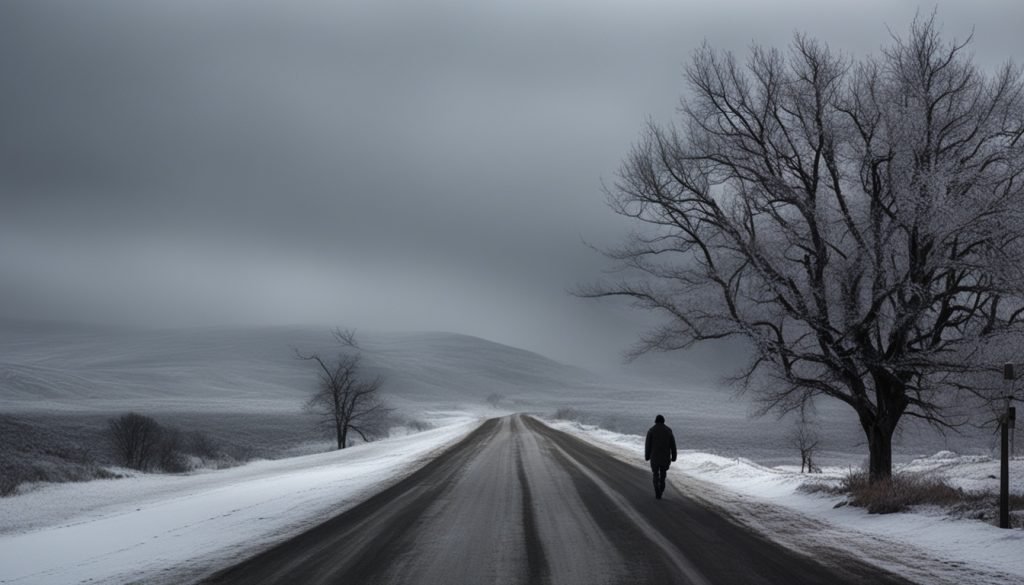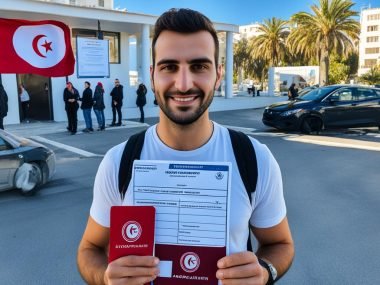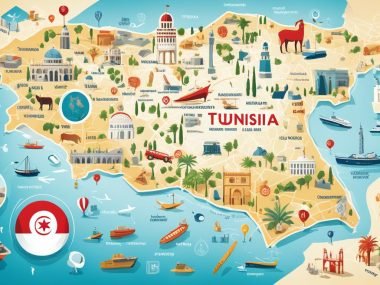Thinking of visiting Tunisia when it’s cold? You may ask, “How chilly does it get?” Tunisia’s winter weather changes a lot because of its geography. By the Mediterranean, places like Tunis have gentle winters. They average 12.3 °C (54.1 °F) in January. But, head inland, and it gets colder at night, sometimes near freezing.
Near the coast, there’s enough rain to make winter okay. But, go inland, and winter nights are much tougher. This makes Tunisia interesting for different visitors.
Key Takeaways
- Winter temperatures in Tunisia vary between the coast and inland.
- Tunis and coastal areas have mild winters, around 12.3 °C (54.1 °F) in January.
- Inland deserts can get very cold at night, even freezing.
- The northern coast gets moderate rain in winter.
- Tunisia’s diverse winter weather attracts various visitors.
Tunisia’s Winter Climate Overview
Tunisia’s winter is a time of varied weather, due to the country’s diverse landscape. The coast enjoys a typical Mediterranean climate. It has mild temperatures and a good amount of rain, especially in late autumn and winter.
Inland, it’s a different story. The climate shifts from semi-desert to full desert as you go south. The rainfall decreases significantly in these areas. Yet, the coastal areas have winter highs of around 16 to 18°C. This makes the coast very appealing during winter.
The desert wind, known as the ‘chergui’, affects Tunisia’s winter too. This wind can greatly increase temperatures and lower humidity, sometimes causing sandstorms. While it’s more common in summer, it can still happen in winter, mostly inland.
| Region | Typical Winter Highs (°C) | Rainfall Pattern |
|---|---|---|
| Coastal Areas | 16-18°C | Frequent rainfall, especially late autumn and winter |
| Inland Regions | Variable, lower than coastal | Decreasing rainfall from north to south |
| Desert Areas | Highly variable | Minimal rainfall, occasional sandstorms |
Tunisia during winter showcases a fascinating mix of climates. From rainy coasts to dry, wind-swept interiors, the country’s winter is diverse and appealing.
Average Winter Temperatures in Northern Tunisia
Northern Tunisia, especially around Tunis, has moderate rain and various temperatures year-round. The northern Tunisia climate sees average January temperatures of 12.3 °C. This makes it somewhat mild during the winter. From September to April, rain is more common, with Tunis getting around 485 millimetres yearly.
Cities like Bizerte get even more rain, showing the wider Tunisia winter temperature trends in the area.

Even with colder winters, the Tunisian sea stays warm enough for swimming until September. It starts getting cold by December and stays that way until May. This mix of mild weather and seasonal changes makes northern Tunisia great for visitors wanting a unique Tunisia winter temperature experience. So, knowing the northern Tunisia climate details is key for anyone planning a visit to enjoy the region’s winter charm fully.
| Month | Average Temperature (°C) | Rainfall (mm) |
|---|---|---|
| January | 12.3 | 55 |
| February | 13.0 | 45 |
| March | 15.0 | 50 |
| April | 17.0 | 40 |
Sea Temperatures and Conditions Along the Tunisian Coast
The coastal areas of Tunisia show a stable trend in temperature. In the Gulf of Hammamet, places like Sousse get very hot in summer, reaching up to 32/33 °C. This region sees its yearly rain fall from 300/400 mm to around 200 mm by the Gulf of Gabès.
As winter arrives, the sea temperatures in Tunisia start to drop. This makes the sea cooler. Even so, the coast keeps its charm with lots of winter sunshine and less rain, especially when compared to the north.
The cooler winter doesn’t stop people from enjoying outdoor fun along the Tunisian coast. From December to May, swimming might be less common due to cooler sea temperatures. But the friendly weather ensures the coast is always lively and attractive to visitors.
| Region | Summer Daytime Temperatures (°C) | Annual Precipitation (mm) |
|---|---|---|
| Gulf of Hammamet | 32/33 | 300/400 |
| Gulf of Gabès | 32/33 | 200 |
In winter, the Tunisian coast enjoys plenty of sunshine and gets less rain than the north. This creates an ideal environment for discovering and enjoying the many attractions along the coast.
Tunisia’s Winter Rainfall Patterns
To understand Tunisia’s winter rain, we must look at its varied geography. The north gets more rain than the south due to weather from the Mediterranean and Atlantic.
Rainfall Comparison: Northern vs. Southern Tunisia
In cities like Tunis in the north, there’s a lot of rain from the Mediterranean. But as you go south, to places like the Gulf of Gabès, it gets drier. This shows the change from a wet climate to a dry, desert environment.
Average Winter Rainfall in Major Cities
It’s interesting to see how winter rain varies in different cities. Tunis and Sousse have different amounts of rainfall. In the Gulf of Hammamet, which has Sousse, rain can reach up to 300/400 mm. But in the Gulf of Gabès to the south, it drops to about 200 mm.
Tunis has steady rain, making it green and lush. Sousse’s rain shows how things get drier as you move south. This shows how diverse Tunisia’s winter weather is.
“Understanding Tunisia’s winter weather can make your visit much better,” I think as I explore its climate variety.
How Cold Does Tunisia Get In Winter?
In Tunisia, winter feels different depending on where you are. Near the coast, like in Tunis, it’s quite mild with the mercury dipping to about 12.3 °C (54.1 °F) during the day.
But, head inland or up into the hills, and it’s a different story. The Tunisia winter temperature gets much chillier. Snow can even sprinkle over the northern mountains, showcasing the country’s winter diversity.
The desert areas inland present a sharp contrast. Here, after sundown, temperatures can drop to zero. This shows just how varied Tunisia’s winter weather can be.
Winter Conditions in Tunisia’s Desert Regions
Winter time brings stark changes to Tunisia’s deserts. They have very clear climate differences with cold nights and minimal rain. We’ll look at how the temperature changes from day to night and the amount of rain it gets.

Daytime vs. Night-time Temperatures
In Tunisia’s deserts, winter means big temperature changes. Days can feel nice but nights get really cold. Tozeur shows this well, with cosy days but desert night-time temperatures dropping below 0 °C. This big change from hot to cold is typical of Tunisia’s desert winter. It means you need to be ready for both the heat and the chill.
Precipitation in Desert Areas
Unlike the coast, Tunisia’s deserts see little rain. Places like Tozeur and El Borma get very little rainfall. Their dry climate is quite different from the country’s wetter areas. This dryness shows how varied Tunisia’s winter weather can be, which is crucial for visitors to know in winter.
| Location | Average Winter Daytime Temperature (°C) | Average Winter Night-time Temperature (°C) | Average Annual Precipitation (mm) |
|---|---|---|---|
| Tozeur | 15 | -2 | 75 |
| El Borma | 14 | -1 | 50 |
| Douz | 16 | 0 | 60 |
Preparing for a Winter Visit to Tunisia
When planning your Tunisia winter travel, it’s essential to pack appropriately for the country’s diverse climate. In coastal areas like Tunis, you’ll need autumn clothes, including a jacket and raincoat. This is to stay warm and dry during the mild and sometimes rainy weather. If you’re visiting Tunisia in winter and going to the mountains, remember to pack warmer clothes because it gets cooler.
For the desert areas of Tunisia, light clothing is best during the day. At night, you’ll need extra layers because it gets chilly. Don’t forget to bring items that protect against sand and dust. No matter where you go in Tunisia, always use sun protection. Sunglasses and sunscreen are essential to enjoy the bright winter sun safely.
| Region | Recommended Clothing | Additional Tips |
|---|---|---|
| Coastal Areas | Autumn attire with a jacket and raincoat | Be prepared for mild temperatures and occasional rain |
| Mountainous Areas | Warm clothing | Consider layers to manage varying conditions |
| Desert Regions | Light day clothing with extra layers for evenings | Protection against sand and dust |
As you prepare for your Tunisia winter travel, getting ready for the different climates is key. Whether you’re exploring coastal towns or desert landscapes, the winter in Tunisia offers a unique experience. Pack wisely and enjoy the adventure in this stunning North African country.
Conclusion
Tunisia in winter is a mix of mild coastal weather and cold desert temperatures. This means travellers need to understand the local weather patterns. Along the coast, the weather is shaped by the Mediterranean. In the desert, it’s much different, with vast open spaces.
Planning your visit in the colder months means paying attention to the weather. Bring the right clothes and gear for your trip. This way, you can enjoy both the cool sea breezes and the clear desert nights. Tunisia’s rich culture and stunning scenery are waiting for you in winter.
Winter in Tunisia offers a wide range of experiences. Knowing about the weather and preparing for it is important. You can then enjoy the beautiful coast, bustling markets, and peaceful deserts. The key to a great trip is to understand and respect Tunisia’s diverse winter weather.







